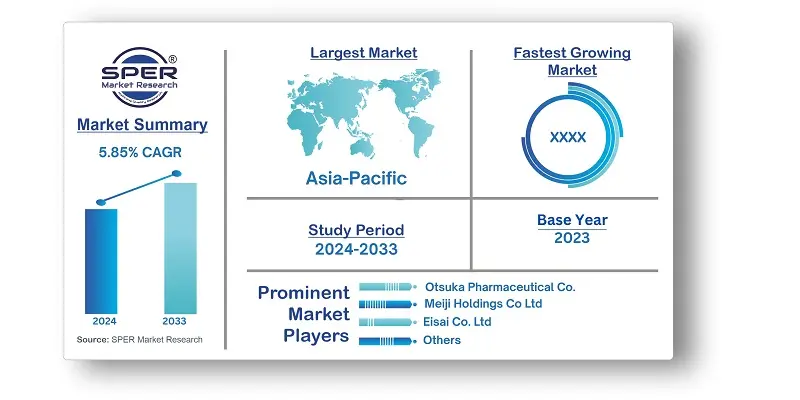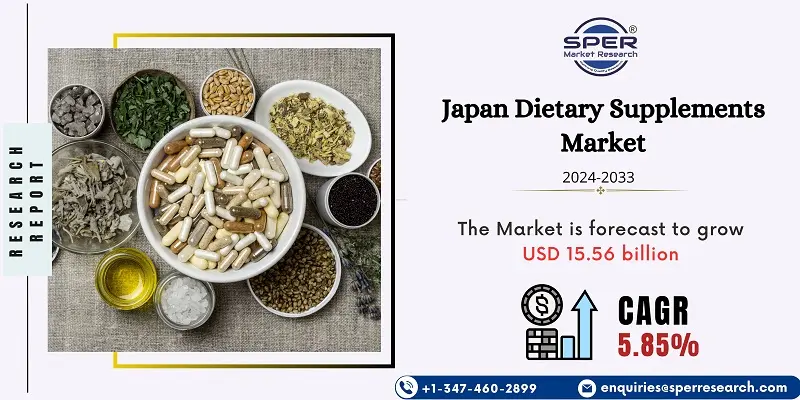
Japan Dietary Supplements Market Trends, Share, Size, Demand, Revenue and Future Outlook
Japan Dietary Supplements Market Growth, Size, Trends Analysis- By Type, By Mode of Application, By Distribution Channel- Regional Outlook, Competitive Strategies and Segment Forecast to 2033
| Published: Nov-2024 | Report ID: NUTR2402 | Pages: 1 - 102 | Formats*: |
| Category : Nutraceuticals | |||
- Kirin Holdings has agreed to acquire Australian vitamin company Blackmores in April 2023 as part of the Japanese brewer's expansion into health products to reduce its reliance on beer. Kirin is expanding into healthcare as the alcoholic beverage industry becomes more controlled. Kirin's move away from beer contrasts with larger competitors like Anheuser-Busch InBev and Asahi Group Holdings, which are doubling down on alcohol and investing in higher-end sectors like craft breweries.
- In April 2023, a well-known Japanese oyster brand entered the supplement sector by launching zinc-rich pills made from oyster components, aimed for beauty and health-conscious women. The "8th Sea Oyster Supplement" was created by Professor Hitoshi Shirakawa of Tohoku University's Graduate School of Agricultural research, who specializes in nutritional research and molecular biology.
- Neopharma Japan released "WIZALA," the first 5-ALA supplement for pups and kittens, in October 2022.


| Report Metric | Details |
| Market size available for years | 2020-2033 |
| Base year considered | 2023 |
| Forecast period | 2024-2033 |
| Segments covered | By Type, By Mode of Application, By Distribution Channel |
| Regions covered | Kanto Region, Kniki Region, Central/Chubu Region, Kyushu-Okinawa Region, Chugoku Region Shikoku Region |
| Companies Covered | Takeda Pharmaceutical Company Limited, Otsuka Pharmaceutical Co., Ltd, Daiichi Sankyo Company, Limited, Eisai Co. Ltd, Meiji Holdings Co Ltd. |
- Health-conscious individuals
- Aging population
- Sports and fitness enthusiasts
- Women (pregnancy and menopause)
- Individuals with specific health concerns
- Vegan and vegetarian consumers
- Children and adolescents
| By Type: | |
| By Mode of Application: | |
| By Distribution Channel: | |
| By Region: |
- Japan Dietary Supplements Market Size (FY’2024-FY’2033)
- Overview of Japan Dietary Supplements Market
- Segmentation of Japan Dietary Supplements Market By Type (Minerals, Vitamins, Enzymes, Probiotics, Botanicals, Amino Acids, Others)
- Segmentation of Japan Dietary Supplements Market By Mode of Application (Tablets, Capsules, Liquid, Powder, Soft Gels, Gel Caps)
- Segmentation of Japan Dietary Supplements Market By Distribution Channel (Pharmacy, Supermarket/Hypermarket, Online)
- Statistical Snap of Japan Dietary Supplements Market
- Expansion Analysis of Japan Dietary Supplements Market
- Problems and Obstacles in Japan Dietary Supplements Market
- Competitive Landscape in the Japan Dietary Supplements Market
- Impact of COVID-19 and Demonetization on Japan Dietary Supplements Market
- Details on Current Investment in Japan Dietary Supplements Market
- Competitive Analysis of Japan Dietary Supplements Market
- Prominent Players in the Japan Dietary Supplements Market
- SWOT Analysis of Japan Dietary Supplements Market
- Japan Dietary Supplements Market Future Outlook and Projections (FY’2024-FY’2033)
- Recommendations from Analyst
1.1. Scope of the report1.2. Market segment analysis
2.1. Research data source
2.1.1. Secondary Data2.1.2. Primary Data2.1.3. SPER’s internal database2.1.4. Premium insight from KOL’s
2.2. Market size estimation
2.2.1. Top-down and Bottom-up approach
2.3. Data triangulation
4.1. Driver, Restraint, Opportunity and Challenges analysis
4.1.1. Drivers4.1.2. Restraints4.1.3. Opportunities4.1.4. Challenges
4.2. COVID-19 Impacts of the Japan Dietary Supplements Market
5.1. SWOT Analysis
5.1.1. Strengths5.1.2. Weaknesses5.1.3. Opportunities5.1.4. Threats
5.2. PESTEL Analysis
5.2.1. Political Landscape5.2.2. Economic Landscape5.2.3. Social Landscape5.2.4. Technological Landscape5.2.5. Environmental Landscape5.2.6. Legal Landscape
5.3. PORTER’s Five Forces
5.3.1. Bargaining power of suppliers5.3.2. Bargaining power of buyers5.3.3. Threat of Substitute5.3.4. Threat of new entrant5.3.5. Competitive rivalry
5.4. Heat Map Analysis
6.1. Japan Dietary Supplements Market Manufacturing Base Distribution, Sales Area, Product Type6.2. Mergers & Acquisitions, Partnerships, Product Launch, and Collaboration in Japan Dietary Supplements Market
7.1. Japan Dietary Supplements Market Size, Share and Forecast, By Type, 2020-20267.2. Japan Dietary Supplements Market Size, Share and Forecast, By Type, 2027-20337.3. Minerals7.4. Vitamins7.5. Enzymes7.6. Probiotics7.7. Botanicals7.8. Amino Acids7.9. Others
8.1. Japan Dietary Supplements Market Size, Share and Forecast, By Mode of Application, 2020-20268.2. Japan Dietary Supplements Market Size, Share and Forecast, By Mode of Application, 2027-20338.3. Tablets8.4. Capsules8.5. Liquid8.6. Powder8.7. Soft Gels8.8. Gel Caps
9.1. Japan Dietary Supplements Market Size, Share and Forecast, By Distribution Channel, 2020-20269.2. Japan Dietary Supplements Market Size, Share and Forecast, By Distribution Channel, 2027-20339.3. Pharmacy9.4. Supermarket/Hypermarket9.5. Online
10.1. Japan Dietary Supplements Market Size and Market Share
11.1. Japan Dietary Supplements Market Size and Market Share By Region (2020-2026)11.2. Japan Dietary Supplements Market Size and Market Share By Region (2027-2033)11.3. Kanto Region11.4. Kinki Region11.5. Central/ Chubu Region11.6. Kyushu-Okinawa Region11.7. Chugoku Region11.8. Shikoku Region
12.1. Takeda Pharmaceutical Company Limited
12.1.1. Company details12.1.2. Financial outlook12.1.3. Product summary12.1.4. Recent developments
12.2. Otsuka Pharmaceutical Co., Ltd
12.2.1. Company details12.2.2. Financial outlook12.2.3. Product summary12.2.4. Recent developments
12.3. Daiichi Sankyo Company, Limited
12.3.1. Company details12.3.2. Financial outlook12.3.3. Product summary12.3.4. Recent developments
12.4. Eisai Co., Ltd
12.4.1. Company details12.4.2. Financial outlook12.4.3. Product summary12.4.4. Recent developments
12.5. Meiji Holdings Co., Ltd
12.5.1. Company details12.5.2. Financial outlook12.5.3. Product summary12.5.4. Recent developments
12.6. Others
SPER Market Research’s methodology uses great emphasis on primary research to ensure that the market intelligence insights are up to date, reliable and accurate. Primary interviews are done with players involved in each phase of a supply chain to analyze the market forecasting. The secondary research method is used to help you fully understand how the future markets and the spending patterns look likes.
The report is based on in-depth qualitative and quantitative analysis of the Product Market. The quantitative analysis involves the application of various projection and sampling techniques. The qualitative analysis involves primary interviews, surveys, and vendor briefings. The data gathered as a result of these processes are validated through experts opinion. Our research methodology entails an ideal mixture of primary and secondary initiatives.



Frequently Asked Questions About This Report
PLACE AN ORDER
Year End Discount
Sample Report
Pre-Purchase Inquiry
NEED CUSTOMIZATION?
Request CustomizationCALL OR EMAIL US
100% Secure Payment






Related Reports
Our Global Clients
Our data-driven insights have influenced the strategy of 200+ reputed companies across the globe.






















